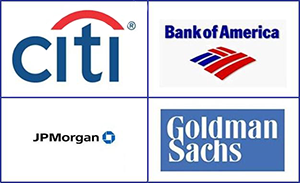By Pam Martens and Russ Martens: August 13, 2018 ~
 On Friday the Dow Jones Industrial Average closed with a loss of 196 points as contagion jitters from Turkey’s worsening situation rattled markets. Among the big Wall Street banks, these were the biggest losers: Citigroup, down 2.39 percent; Morgan Stanley, down 2.12 percent; Goldman Sachs, down 1.78 percent; Bank of America, down 1.30 percent; and JPMorgan Chase closed off by 0.98 percent. Deutsche Bank, the big German lender whose U.S. subsidiary has a big footprint on Wall Street, lost 4.68 percent. Deutsche Bank has now lost 41 percent of its market value since February.
On Friday the Dow Jones Industrial Average closed with a loss of 196 points as contagion jitters from Turkey’s worsening situation rattled markets. Among the big Wall Street banks, these were the biggest losers: Citigroup, down 2.39 percent; Morgan Stanley, down 2.12 percent; Goldman Sachs, down 1.78 percent; Bank of America, down 1.30 percent; and JPMorgan Chase closed off by 0.98 percent. Deutsche Bank, the big German lender whose U.S. subsidiary has a big footprint on Wall Street, lost 4.68 percent. Deutsche Bank has now lost 41 percent of its market value since February.
But the selloff didn’t stop there. Two big U.S. life insurers also tumbled on Friday. MetLife lost 3.19 percent while Prudential Financial was off by 2.97 percent.
What do Wall Street banks and U.S. life insurers have to do with a selloff in Turkey’s currency? Not that much. But they have a lot to do with European banks and European banks have a lot of exposure to Turkey in the way of loans as well as ownership stakes in several large banks in Turkey. According to the Bank for International Settlements, European banks have $194 billion exposure to Turkish debt.
Dragging down the U.S. stock market along with U.S. bank and insurer stocks is the fear that the crisis in Turkey will create a selloff contagion in European banks – which are big counterparties to trillions of dollars in derivatives held by the largest Wall Street banks. Likewise, MetLife and Pru are derivative counterparties.
The Office of Financial Research (OFR), the Federal agency at which the Trump administration cut 40 jobs last week after slashing its budget by 25 percent, warned about all of this in its 2016 annual report. The following excerpt sums up the growing panic on Wall Street:
“U.S. global systemically important banks (G-SIBs) have more than $2 trillion in total exposures to Europe. Roughly half of those exposures are off-balance-sheet…U.S. G-SIBs have sold more than $800 billion notional in credit derivatives referencing entities domiciled in the EU.”
The OFR report had this to say about U.S. insurers and derivatives:
“At the end of 2015, U.S. life insurers’ derivatives exposure, as reported in statutory filings, totaled $2 trillion in notional value. This $2 trillion does not include derivative contracts held in affiliated reinsurers, non-insurance affiliates, and parent companies that do not have to file statutory statements. Details on these entities’ derivatives positions are not publicly available.”
The OFR report then captured the daisy chain for future panic and contagion with this passage:
“According to statutory data on insurance company legal entities, nine large U.S. and European banks are counterparties to about 60 percent of U.S. life insurers’ $2 trillion in notional derivatives. These data show that despite central clearing, derivatives interconnectedness between the U.S. life insurance industry and banks remains substantial.”
Then came the sine qua non for regulatory capture by the Wall Street banks. The OFR wrote:
“Deficiencies in data and data management remain a critical vulnerability. Data needs remain unfilled, particularly in shadow banking markets. Many of the new data are not ready or available for analysis. Despite progress, the probability remains high that data deficiencies will again prevent risk managers and regulators from assessing risks before it is too late.”
Let that sink in for a moment. After the 2008 Wall Street financial crisis, fueled in its severity by derivatives, produced the largest economic downturn since the Great Depression, the U.S. still has not put in place the tools to properly assess risk – forcing the public to remain in the dark about the health of the U.S. financial system.
In addition to the derivatives fears in U.S. and European markets, there is also the concern that Turkey’s problems will engulf the currencies of other emerging markets – potentially leading to defaults on U.S. dollar-denominated debt which could become prohibitively expensive to repay with weakened currencies. Collectively, Wall Street banks do have significant exposure to emerging market debt.
Contagion among the emerging market currencies is rearing its head this morning with the South African rand and Mexican peso under pressure in early morning trading.
The situation in Turkey is this: the Turkish lira has lost more than 40 percent of its value versus the U.S. dollar over the past year, making its sizable dollar-denominated debts harder to repay; interest rates are at 17.75 percent in Turkey, making further hikes by the central bank to support the currency unpopular; inflation is running at 15 percent. On Friday, U.S. President Donald Trump delivered another unwelcome gut punch by announcing the following in a Tweet:
“I have just authorized a doubling of Tariffs on Steel and Aluminum with respect to Turkey as their currency, the Turkish Lira, slides rapidly downward against our very strong Dollar! Aluminum will now be 20% and Steel 50%. Our relations with Turkey are not good at this time!”
Trump is reportedly annoyed that Turkey’s President Recep Tayyip Erdogan refuses to comply with U.S. sanctions against Iran and is refusing to release U.S. Pastor Andrew Brunson, who is being held on charges of terrorism. Trump is apparently unaware, or doesn’t care, that when he punches Erdogan in the gut, he’s putting the Wall Street banks and their derivatives mess at risk.

